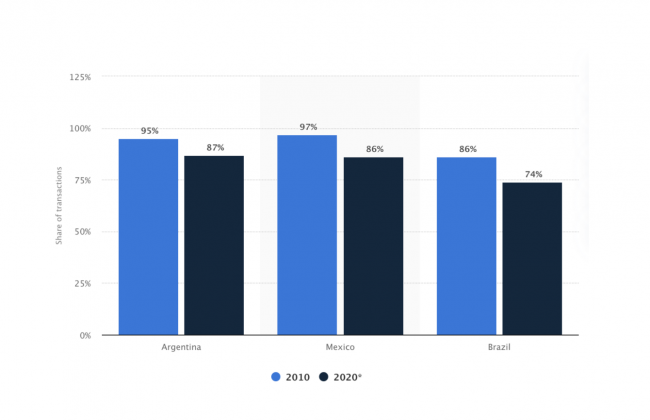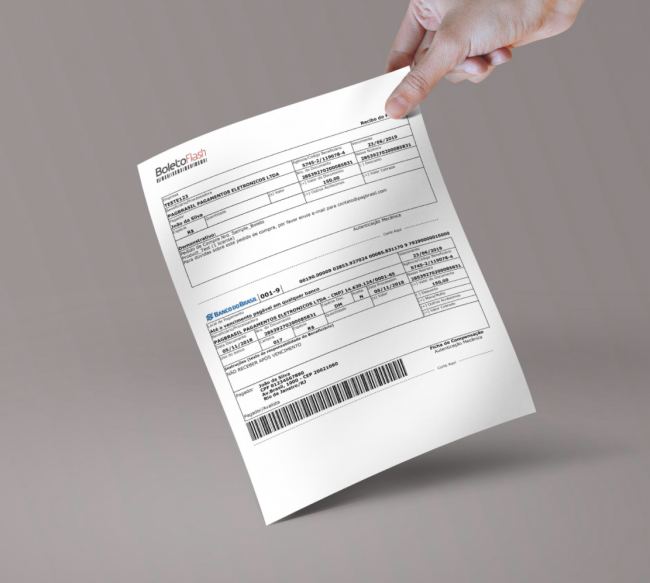Here in Brazil, we say that when you join fintech and e-commerce, you become addicted to it.
That’s exactly what happened to me when I joined Fintech 8 years ago – and I have not looked back.
Fintech and eCommerce are among the fastest-growing sectors in business across the world, but especially in Latin America. So why is this region particularly poised for strong growth?
Approximately 70% of the 650 million people living in Latin America are unbanked or underbanked, and fintech companies are leveraging digital technologies to bring them financial services. It is important to pay close attention to trends, as they can affect how and where your company does business. They can also open up new opportunities for you.
Here are five big trends that I am seeing in the fintech and eCommerce space across Latin America.
1. Reduction in Cash Usage
As we have seen with COVID, the digital transformation from cash to digital payments and conducting “contactless” financial transactions has greatly accelerated. In countries where cash was still widely accepted, its usage dropped dramatically.
Share of cash used in total payment transactions in selected countries in Latin American in 2010 and 2020. Source: Statista

Merchant companies that are more focused on credit/debit cards, digital wallets, and have the capabilities to offer the services consumers need will be best positioned to lead this expansion.
In Brazil, cards, especially credit cards, are now an indispensable payment method, accounting for 59% of online transactions.
2. The Prevalence of Installment Payments
The unique thing about the Brazilian payments landscape is the preference to pay in installments, which are payment plans that allow consumers to pay off a purchase over the course of a few months or years without paying interest. Installments are a very popular and unique feature of the LATAM region. Approximately 50% of all ecommerce in Brazil is done via installments. They have different names in different regions—for example, they are called quotas in Argentina and months without interest in Mexico. This payment type is typically used for larger purchases, enabling Latin American consumers to purchase necessities like appliances as well as discretionary purchases such as electronics, jewelry, or travel.
3. Rise of Local Payment Methods
Each country in Latin America has its own preferred local payment methods.
In Brazil, Boleto is widely used in rural and underprivileged regions that are still largely unbanked or do not have access to credit. For those unfamiliar with Boleto, it is like a voucher. It is paper-based so the consumer can print it out, and it comes with a scannable barcode. When scanned, it triggers a bank transfer, where the money will be transferred from the consumer’s bank account to the client’s. Boleto is typically used to pay bills rather than purchase big-ticket items, and is also not real-time, it has a two-day settlement window.

Another payment method gaining popularity in Brazil is PIX. PIX is a local real-time payment method initiated by the Central Bank. It is loved by the Brazilian people and has gained popularity quickly in the last few months, replacing the TED/DOC (one of the most common bank transfer methods in the past), as it is faster, cheaper, and accessible 24/7. Colombia has a similar payment method called PSI, and Mexico has a real-time payment network called SPEI.
4. Embedded Finance
Consumer tech companies – like ride-hailing firms and delivery apps – are already embedding fintech into their applications. One interesting example of this evolution is Rappi, a Colombia-based delivery company that now operates in 9 countries across the region and offers RappiPay, a proprietary mobile wallet. Some other examples with similar strategies are Uber, DoorDash, and Didi with their wallet DidiPay.
I think that in the future, the ability to offer and integrate financial services will be a crucial growth and retention factor in most technology companies’ success. Fintech platforms like Rapyd can support this trend and offer APIs allowing innovators to build their own financial services companies and digital banks under their own brand.
5. Neobanks
Another subgroup in the fintech sector in Latin American that sees skyrocketing growth in popularity is Neobanks. Neobanks are online-only financial institutions that address the main pains or problems of the general population: access, convenience and speed of operations. Large institutions typically cannot and do not have the agility to keep up with the pains of their consumers or the rapid changes in markets.
I am seeing a lot of new banks that are helping the general population. Most are like traditional banks in some ways, although they have some important differences: one of the most distinctive features of neobanks is the fact that they only offer certain services—for instance, they may only offer customers checking or savings accounts.
One of the hottest neobanks, NuBank, attracted significant funding recently – this is a direct impact of the great market fit and product vision that aims to offer a fair, simple and transparent service.
6. Rise of Digital Wallets
A digital wallet created on a digital site like MercadoPago and Paypal allows one party to make electronic transactions to another party. The user can store funds, make transactions, and track payment histories among other features. For P2P and online payments some consumers are turning towards these third-party payment systems rather than using traditional or online banks.
Putting These Trends to Work for your Business
Innovation in the fintech space often comes from regulators who make changes that are favorable to the population and incentivize innovation in financial services. This will make the market increasingly digitalizing and evolving, favoring the emergence of fintechs serving Latin America.
I believe that consumer preferences will continue to evolve fast, and companies that are able to meet consumer expectations will win a large share of the LATAM consumer population. There is a tremendous opportunity to leverage these emerging trends across all segments – from EduTech and Healthtech, to Digital Banking, eCommerce and Gig Economy.
Companies looking to enter or expand in Latin America should be prepared to offer locally-focused services and adjust their solutions. They must localize, or, as we say in Brazil, tropicalize their approach and solutions – in other words, understand the payment culture of each country, adjust the payment solutions and offer installments, real-time payments, local settlements and costs that are right for each region.
Photo from Pexels from Andrea Piacquadio.
Written by Victor Lucena, Business Development Manager, Rapyd.
Subscribe Via Email
Thank You!
You’ve Been Subscribed.



